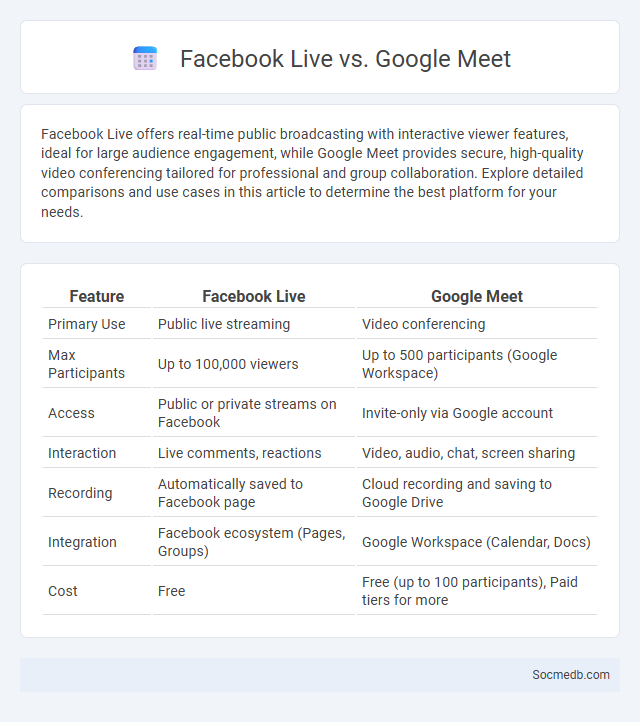
Photo illustration: Facebook Live vs Google Meet
Facebook Live offers real-time public broadcasting with interactive viewer features, ideal for large audience engagement, while Google Meet provides secure, high-quality video conferencing tailored for professional and group collaboration. Explore detailed comparisons and use cases in this article to determine the best platform for your needs.
Table of Comparison
| Feature | Facebook Live | Google Meet |
|---|---|---|
| Primary Use | Public live streaming | Video conferencing |
| Max Participants | Up to 100,000 viewers | Up to 500 participants (Google Workspace) |
| Access | Public or private streams on Facebook | Invite-only via Google account |
| Interaction | Live comments, reactions | Video, audio, chat, screen sharing |
| Recording | Automatically saved to Facebook page | Cloud recording and saving to Google Drive |
| Integration | Facebook ecosystem (Pages, Groups) | Google Workspace (Calendar, Docs) |
| Cost | Free | Free (up to 100 participants), Paid tiers for more |
Introduction to Live Video Platforms
Live video platforms revolutionize real-time content sharing by enabling instant interaction and authentic engagement. You can broadcast events, tutorials, or personal moments directly to audiences on platforms like Twitch, YouTube Live, and Facebook Live. These tools harness the power of immediacy and community connection, driving higher viewer retention and enhanced social presence.
Overview of Facebook Live
Facebook Live enables users to broadcast real-time video content directly to their audience, fostering immediate engagement through comments, reactions, and shares. This platform integrates seamlessly with Facebook's extensive social graph, allowing broadcasters to reach targeted demographics and drive organic reach efficiently. Leveraging interactive features like polls and Q&A, Facebook Live enhances viewer participation and boosts visibility within the social media ecosystem.
Exploring Google Meet Features
Google Meet offers advanced video conferencing features designed for seamless communication, including screen sharing, real-time captions powered by Google's speech recognition technology, and integration with Google Workspace apps like Calendar and Drive. Its AI-driven noise cancellation and low-light mode enhance call quality, ensuring professional interactions even in challenging environments. The platform supports large meetings with up to 500 participants, breakout rooms for focused discussions, and robust security protocols including encryption and access controls, making it ideal for social media teams collaborating on content creation and strategy.
What is Live Streaming?
Live streaming is a real-time video broadcasting method that enables users to share events, activities, or experiences instantly with a global audience via platforms like Facebook Live, YouTube Live, and Twitch. This interactive medium allows viewers to engage through comments, reactions, and shares, fostering immediate communication and community building. Its applications span entertainment, education, marketing, and gaming, making live streaming a versatile tool for personal expression and brand promotion.
User Experience and Interface Comparison
Social media platforms vary significantly in user experience (UX) and user interface (UI) design, impacting how easily you can navigate and engage with content. Platforms like Instagram emphasize visual storytelling through intuitive swipe gestures and minimalist layouts, while Facebook offers complex menus and richer content options that may feel overwhelming for some users. Optimizing your choice based on these UI/UX differences ensures smoother interaction and enhances your overall satisfaction on social media.
Audience Engagement Tools
Audience engagement tools on social media platforms enhance interaction by offering features such as polls, quizzes, and live streaming, which encourage active participation. These tools provide valuable analytics to track your audience's preferences and behaviors, enabling tailored content strategies. By leveraging these capabilities, you can boost engagement rates and foster a loyal community around your brand.
Accessibility and Platform Compatibility
Ensuring social media platforms prioritize accessibility features, such as screen reader support and captioning, maximizes user engagement across diverse audiences. Your content should be optimized for compatibility across devices and operating systems, including iOS, Android, and web browsers, to provide a seamless user experience. Implementing inclusive design standards improves reach and interaction, benefiting both users and platform performance.
Privacy and Security Features
Social media platforms implement robust privacy and security features such as end-to-end encryption, two-factor authentication, and customizable privacy settings to protect user data from unauthorized access. Advanced algorithms detect suspicious activities and phishing attempts while regular security audits ensure the integrity of user accounts and personal information. Compliance with regulations like GDPR and CCPA further enhances transparency and control over data sharing and user consent.
Use Cases: Business, Education, and Personal
Social media platforms enhance business outcomes by enabling targeted marketing, customer engagement, and real-time feedback through tools like Facebook Ads and LinkedIn. In education, platforms such as Twitter and YouTube facilitate collaborative learning, access to expert content, and virtual classrooms, enriching student interaction and resource availability. Personal use centers on social connectivity, self-expression, and information sharing, with Instagram and TikTok driving trends and community formation.
Choosing the Right Live Video Solution
Selecting the right live video solution involves evaluating platform compatibility, streaming quality, and audience engagement features. Key considerations include latency, ease of use, and integration with social media channels like Facebook Live, YouTube Live, or Instagram Live. Optimal solutions provide real-time analytics, multi-platform broadcasting, and robust security to enhance user experience and brand reach.
 socmedb.com
socmedb.com